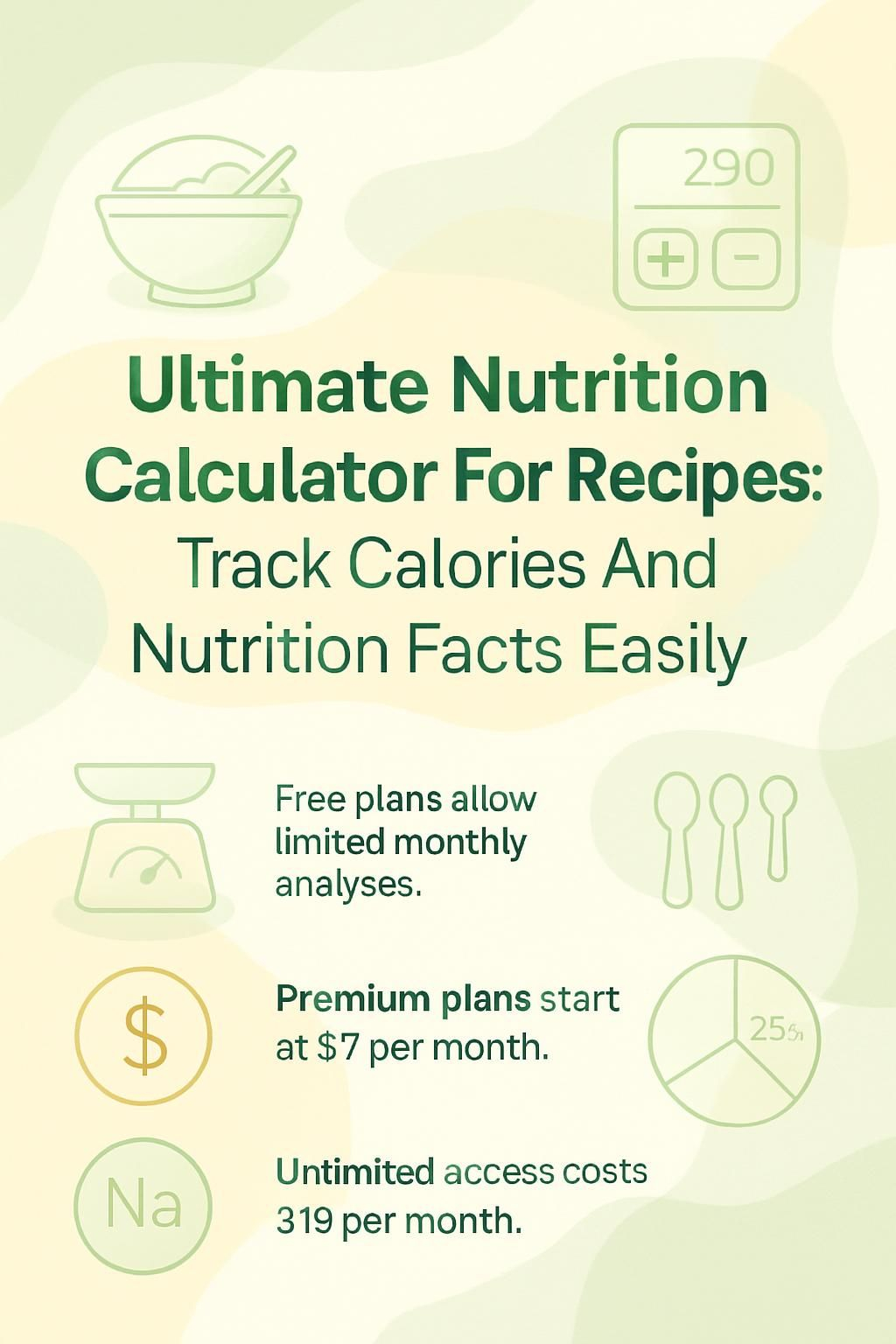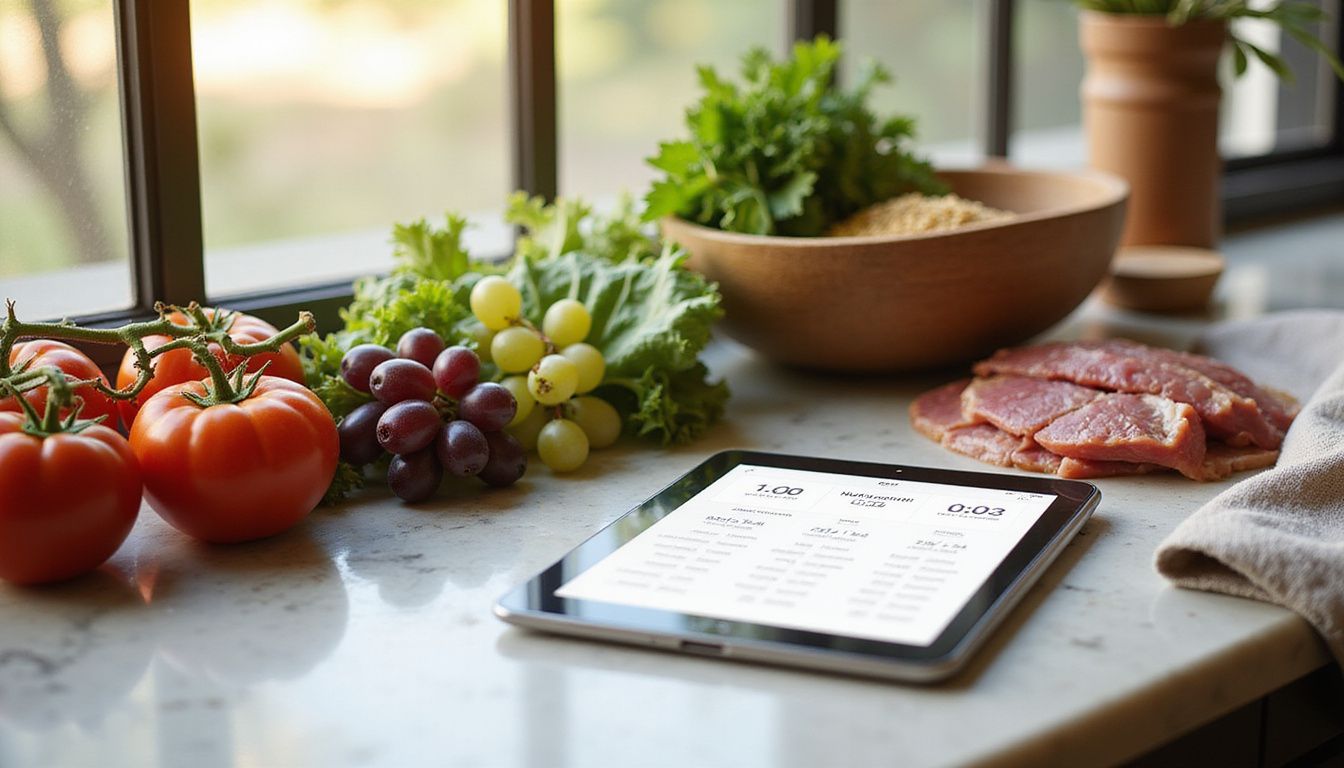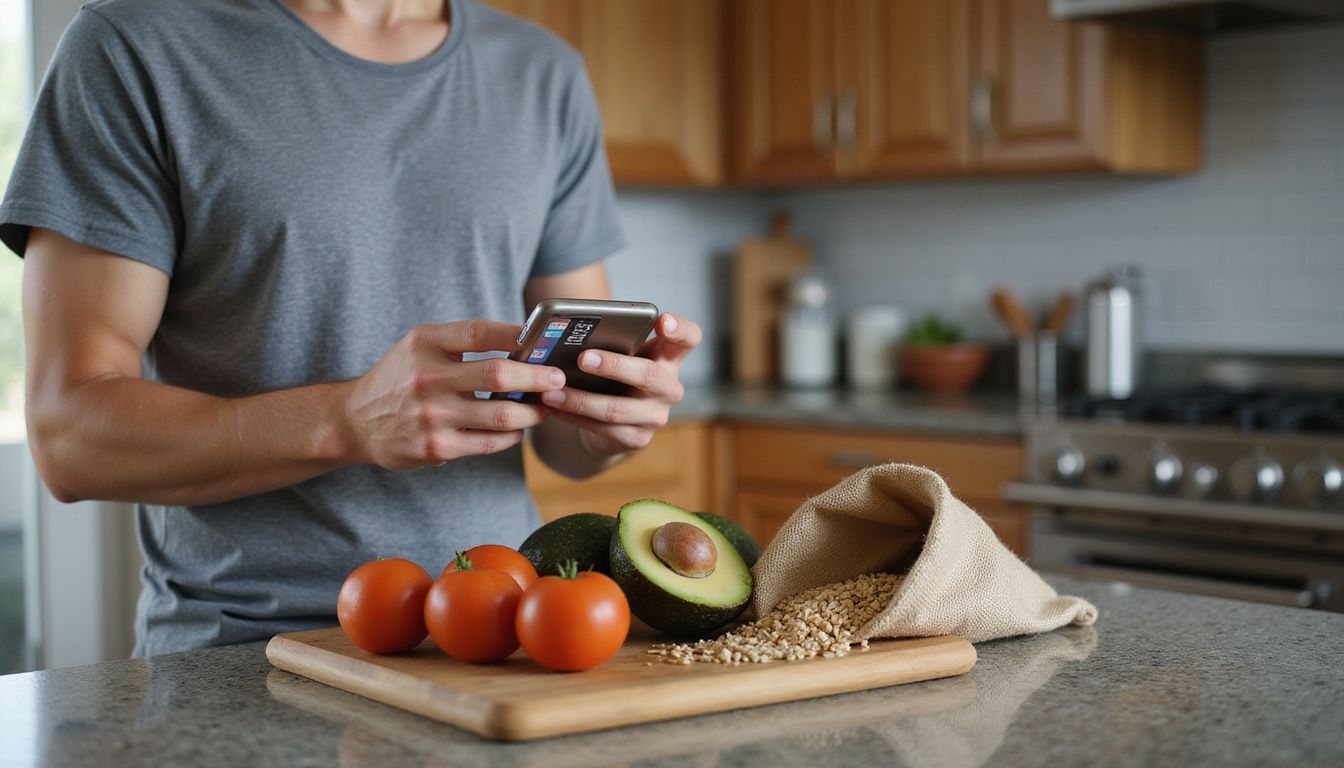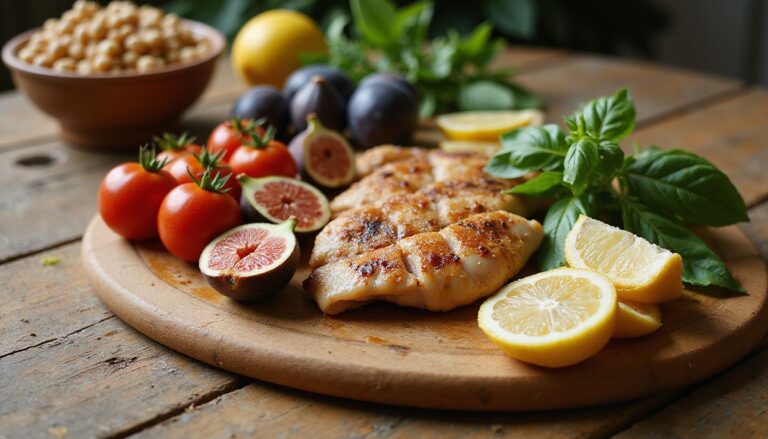Ultimate Nutrition Calculator For Recipes: Track Calories And Nutrition Facts Easily
Our Nutrition Assistant AI Suite will transform your body. You will lose fat, get toned, and build muscle. Gain confidence and optimal health.
Many people want to know what is in their food. Still, tracking calories and nutrition facts for homemade meals can feel confusing. A recipe nutrition calculator turns that guesswork into clear numbers you can use.
Most tools pull data from the USDA FoodData Central, a trusted database. That means the calorie and nutrient values for each ingredient match national standards for food reporting.
This guide shows how to enter ingredients, set servings, and generate a Nutrition Facts label in minutes. Keep reading to see how easily you can calculate a meal’s nutritional value and use it every day.
Key Takeaways
- Recipe nutrition calculators use USDA data to analyze ingredients and servings, giving accurate calories, macros, and vitamins and minerals per meal.
- Free plans allow a limited number of recipe analyses each month; premium starts at $7 per month with FDA-compliant labels, and Unlimited removes analysis caps for $19 per month.
- Helpful features include AI serving size estimates, portion controls, allergy flags, and support for diets like keto, vegan, gluten-free, paleo, and Whole30.
- For precise results, enter every ingredient, including oils and additives. Changes to the recipe update nutrients instantly and follow FDA labeling rules.
- Tracking key nutrients supports health goals or chronic conditions. Targets often include sodium 2,300 mg, added sugars 50 g, fiber 28 g, calcium 1,300 mg, and iron 18 g per day.

How Does a Recipe Nutrition Calculator Work?

A recipe nutrition calculator uses reliable food databases, often from the USDA, to analyze your recipe. It totals calories and nutrition facts based on ingredients and serving size, then shows results per serving and for the whole dish.
What is the purpose of a recipe nutrition calculator?
A recipe nutrition calculator helps me track calories, nutrition facts, and ingredient data for any meal I cook. I use it to see nutrients per serving or for the full batch. It also creates custom Nutrition Facts labels using USDA data, which makes comparing recipes simple.
If I want to cut calories or lower carbs, the analyzer points to the ingredients driving those numbers. I can adjust and see the impact right away.
This tool supports goals for keto, vegan, Whole30, gluten-free, and paleo eating patterns. I can see each ingredient’s contribution, including macros like protein and fat and micronutrients such as iron and potassium.
Tracking portion size keeps my daily values grounded in real servings. That helps with fitness planning and with managing a health condition. Next, here is how the calculator actually operates.
How do recipe nutrition calculators operate?
I can input ingredients by typing them in, searching by name, pasting a recipe URL, or uploading a photo. The system pulls structured ingredient data from supported sites and shows weights for each item.
AI models estimate serving sizes based on what I enter or upload. The tool then calculates calories, percent Daily Value, macros, and vitamins and minerals per serving and per recipe.
Filters help me sort recipes by nutrition, prep time from 15 minutes to 2 hours, cuisine, and diet needs like keto or vegan. I can fine tune results by changing portion sizes with dynamic controls before saving my favorite dishes.
I track both total calories and nutrients per serving using these features.
These tools also help with allergy checks and diet preferences. I can see how each meal contributes to my daily diet. Next are the benefits for health and day to day planning.
Benefits of Using a Recipe Nutrition Calculator
A recipe nutrition calculator shows me the calories and nutrients in my meals. Knowing the numbers helps me choose recipes that fit my goals with less guesswork.
How can I monitor calories and nutrients precisely?
I use a recipe analyzer to track calories, protein, carbs, and fats per serving. The calculator pulls exact USDA values for every ingredient, including limits many people monitor such as saturated fat up to 20 g per day, sodium 2,300 mg per day, cholesterol 300 mg per day, and added sugars 50 g per day.
Ingredient weights appear in ounces and grams, so switching between US and Metric units is fast.
Nutrition facts update the moment I change the number of servings or edit an ingredient. I often check my own daily targets, for example 2,000 calories, 50 g protein, 275 g carbs, and 78 g fat.
Trends over time show up in basic usage stats, and health filters let me compare recipes by calories or nutrients. That supports accurate planning without relying on rough estimates.
How does a nutrition calculator provide tailored dietary feedback?
The calculator analyzes each ingredient, totals calories, and breaks down nutrition facts using a clear formula. It shows my progress toward daily values for protein, carbs, and fat. It also highlights limits for saturated fat, sodium, cholesterol, and sugars on a 2,000 calorie baseline.
I sometimes get prompts if I lack fiber or vitamin C. For example, the tool flags low calcium if I fall below 1,300 mg per day or low iron under 18 mg per day.
Diet filters help me find vegan or gluten-free choices, and I can track minerals such as potassium at 4,700 mg per day. Helpful suggestions appear when an ingredient conflicts with my goal settings.
The tool is guidance, not medical advice. I consult a health professional for a personal plan.
A warning about high sodium in my favorite soup helped me swap in low sodium broth without losing taste.
What makes nutrition calculators efficient and convenient?
I analyze recipes quickly because the calculator supports several input methods. I can type ingredients, search by name, paste a link, or upload an image for rapid extraction.
AI serving estimates save time and reduce errors in my calorie counter. I can filter by cook time, cuisine, price, popularity, diet type, or healthiness to shape a weekly plan.
Saving recipes to a free account keeps them handy. If the tool misreads an ingredient, built-in troubleshooting helps me fix it fast.
I can download Nutrition Facts labels as PNG files for blogs or client projects that require FDA compliant formatting. Anonymous users are tracked by IP; logged in users by account. Daily limits reset at midnight, and monthly caps refresh on the first of each month.
These features streamline every step, from analysis to sharing, without slowing my routine.
How do they support meal planning and portion control?
Meal planning gets easier once I pick recipes and set servings. The calculator shows per serving calories, macros, and percent Daily Values directly in my web browser.
AI estimates guide portion control with suggested serving sizes based on the recipe data.
I compare recipes to build a balanced plan that meets my calorie or nutrient targets. Filtering by cook time helps me schedule busy nights.
Using ingredient swaps, I can reduce calories or raise protein with data driven changes. This approach supports diets such as keto or vegan while keeping portions steady.
Key Features of Top Nutrition Calculators
Top calculators turn a list of ingredients into clear nutrition facts, which makes planning feel more manageable.
What nutritional details do these calculators provide for recipes?
I see a full nutrient breakdown per serving: calories, protein, total fat, carbohydrates, fiber, sugars, and added sugars. The calculator also lists vitamins and minerals such as calcium, iron, potassium, vitamins A and C, vitamins E and K, B vitamins like folate and riboflavin, plus magnesium, phosphorus, zinc, copper, manganese, and selenium.
Each value shows its percent Daily Value based on a 2,000 calorie diet.
The tool flags nutrients to limit, including saturated fat 20 g per day, sodium 2,300 mg per day, cholesterol 300 mg per day, and added sugars 50 g per day. It also encourages positive targets, for example 28 g of dietary fiber or at least 90 mg vitamin C daily.
Ingredient weights are listed for transparency. I can view values per serving and for the whole recipe. All numbers come from USDA data, which gives me confidence while I track, even if I am also watching my glucose with a continuous glucose monitor under a subscription plan.
How do they ensure compliance with FDA nutrition labeling?
These calculators include all nutrients required by the FDA: calories, total fat, saturated fat, trans fat, cholesterol, sodium, total carbohydrates, dietary fiber, sugars and added sugars, protein, vitamin D, calcium, iron, and potassium.
Labels show the correct serving size and servings per container according to current FDA rules.
Premium users can download labels that match package formatting. PNG exports work well for blogs and product pages. Unlimited plan labels do not include credit branding.
Free users can run analyses but cannot export FDA formatted labels. The data supports transparency, though it is not a medical prescription.
Can I adjust serving sizes dynamically?
Yes. I change serving sizes with a simple menu. AI estimates improve the accuracy of each portion. I can convert units between ounces and grams so the math stays precise.
Serving changes update calories and Daily Values instantly. Ingredient weights recalculate to keep per serving facts aligned in the report and on the label.
Setting servings per container also helps when I need a clear FDA compliant label.
How do they detect allergens and accommodate dietary preferences?
Recipe calculators flag common allergens by showing a clear ingredient list. I can filter by vegetarian, vegan, gluten-free, keto, paleo, or Whole30 and by cuisine such as Italian, Mexican, Chinese, Indian, French, Thai, Japanese, Mediterranean, and American.
If I see a risk like nuts or dairy, I can modify or remove that item. Rare sugars, including tagatose and allulose, appear with clear labels in the summary.
For serious allergies, I contact a medical professional since hidden sources may not appear in general databases. Sorting helps me find recipes that fit my diet rules fast.
What macro and micronutrient breakdowns are included?
Along with allergy flags, calculators show detailed macro and micronutrients per serving: calories, total fat, saturated fat, trans fat, cholesterol, sodium, carbohydrates, dietary fiber, total sugars, added sugars, and protein.
I also see essential vitamins and minerals. These include calcium, iron, potassium, vitamins A, C, E, and K, B vitamins like thiamin, riboflavin, niacin, B6, and B12, plus folate. Key minerals such as magnesium, phosphorus, zinc, copper, manganese, and selenium are listed as well.
All values update when I change ingredients or servings. That makes it easier to hit fiber goals or monitor vitamin C while planning meals at home.
Is it possible to store and share recipes?
Yes. I save analyzed recipes by creating a free account. Saved recipes link to my account so I can edit and update them later.
I download Nutrition Facts labels as PNGs, which is handy for a blog or client work. Some platforms also offer embed codes for sharing recipes across sites.
A collections feature is planned to organize saved recipes in one place. Labels can be posted on external sites so others can view key facts quickly.
Next, here is how to enter ingredients and amounts inside the calculator.
How to Use a Recipe Nutrition Calculator
I add each ingredient, enter the amount, and set servings. Then I get a full breakdown of calories and nutrients for my recipe.
How do I input ingredients and their amounts?
I click +Add Ingredient or type each ingredient on its own line. The tool provides weights for every analysis and supports cups, grams, ounces, and milliliters.
If an ingredient is not recognized, I pick from suggestions or edit it manually. For instance, last week I entered “whole wheat flour 120 g” and used the pencil icon to adjust details before saving.
Accurate proportions are essential since wrong amounts change the entire calorie count. Troubleshooting tools help fix measurement errors when they appear.
Editing or deleting items is simple with icons next to each entry. That keeps my nutrition facts clean and correct.
How do I set the number of servings?
After adding ingredients, I set the number of servings with a dropdown menu. If I want more control, I can set serving size by weight in grams or ounces.
Changing servings updates per serving calories and nutrients right away. Labels also refresh to match the change.
AI can estimate servings from images or links if I need help. This step matters for FDA compliant labeling, since the per serving analysis must be accurate.
How can I generate a nutrition facts label?
Once I input ingredients and set servings, the calculator analyzes my recipe and creates a Nutrition Facts label. It shows calories, fats, carbs, protein, fiber, sugars, vitamins, and minerals per serving.
The label includes serving size and servings per container. Premium and Unlimited users get FDA compliant formatting suitable for food marketing or commercial use.
I download labels as PNG files for posts or to share with friends. Some calculators let me embed labels on websites with a code snippet. Percent Daily Values are added automatically, including handling for rare sugars.
Saving the analysis keeps the label available for updates or later review.
Tips for Accurate Nutritional Analysis
Accurate analysis starts with careful entries. The best calculators use up to date databases to keep results consistent.
How can I ensure ingredient proportions are accurate?
I enter ingredients line by line with clear amounts and units. The dropdown and unit converter help me correct vague entries fast.
I double check the ingredient weights before saving, which reduces errors in the nutrition facts. If something is unclear or unrecognized, I edit the entry using data from a verified source.
Uploading clear food photos can improve recognition. Before I finish, I confirm every quantity matches my kitchen scale or measuring cups.
These steps set a strong base for accurate calorie tracking before I set servings.
How do cooking methods affect nutritional values?
Boiling and steaming can reduce water soluble vitamins like vitamin C and some B vitamins. Frying increases calories because foods absorb oil. The calculator only counts that oil if I add it as an ingredient.
USDA numbers often represent raw values. Cooked values can differ from estimates in the calculator.
High heat and long cook times may lower sensitive nutrients. Baking tends to preserve more nutrients than deep frying. Roasting helps keep minerals but can reduce some vitamins.
For better accuracy, I adjust entries to reflect how I actually cooked the food.
How can I modify recipes for my dietary needs?
Cooking methods affect the final numbers, but swaps often have the biggest impact. I use the calculator to reduce calories, raise protein, or change carb content.
For example, lentils instead of ground beef can cut saturated fat and increase fiber. Diet filters for vegetarian, vegan, gluten-free, keto, paleo, and Whole30 help narrow choices.
The ingredient edit icons make replacements easy. Alerts warn me if sodium or sugar exceed limits and encourage more fiber or vitamin C when needed.
Comparing labels after each swap shows progress. Saving versions over time helps me see which choices work best.
Common Mistakes When Using Nutrition Calculators
Small errors can add up. These simple checks keep your numbers honest.
How do I avoid miscalculating portion sizes?
I set the correct number of servings before running the analysis. Starting with servings lets AI generate a better estimate and keeps portions tied to the true yield.
I adjust servings with the dropdown and recalculate after any ingredient change.
Verifying per serving weights and measurements is key. I compare them with typical serving sizes to find mistakes. I also double check the label before I save or share.
I only save once portions look correct. That prevents confusion later.
What are the risks of choosing incorrect ingredient substitutes?
Wrong substitutes can distort the numbers. If I choose a mismatched item from the dropdown, my totals will not reflect the food I cooked.
For example, replacing “whole milk” with “oat milk” without editing the entry will skew calories, protein, and fat. Rare sugars are labeled automatically, but not every brand is covered in standard data, which can affect carb totals.
Poor swaps may also add allergens or remove key nutrients. I review details for every change and run the analysis again to keep results trustworthy.
Why is it important to account for calories in additives and oils?
Oils and additives can raise calories and fat quickly. A tablespoon of olive oil has about 120 calories. Mayonnaise and creamy dressings add even more.
Calculators do not include unlisted garnishes or toppings. I must enter each add on for an accurate count.
These extras change per serving values and Daily Values. Leaving them out can lead to poor diet choices. Listing every ingredient keeps my recipe data honest for me and anyone using my recipe.
How to Improve Recipes Using Nutrition Calculators
I use a calculator to make my recipes healthier and better balanced without losing flavor.
How can I substitute ingredients for healthier versions?
I make swaps with the +Add button or pencil icon to lower calories or boost protein. The calculator flags nutrients that exceed limits for saturated fat, sodium, cholesterol, and sugar.
I review those warnings before I save. For more fiber and vitamin C, I choose whole grains or add produce where it makes sense.
Comparing labels after each swap gives instant feedback. If I want more ideas, I search recipes that already fit my goals.
Once I like the changes, I save the updated recipe or download a new label for planning. Then I track my daily intake to stay consistent.
How do I track daily nutritional intake?
After making swaps, I log my recipes so the dashboard totals my nutrients for the day. Progress bars show protein, carbs, fat, fiber, vitamin C, and more against a 2,000 calorie plan.
Alerts let me know when saturated fat, sugar, cholesterol, or sodium approach their limits. Serving size changes on a recipe update my totals right away.
Saving recipes lets me create a daily or weekly log to balance meals. The dashboard history makes it easy to review past choices and plan the next week.
How can I adapt recipes for specific diet requirements?
I adjust recipes to meet diet rules using filters for vegetarian, vegan, gluten-free, keto, paleo, and Whole30. I edit the ingredient list to remove or replace items that do not qualify.
I compare the adapted recipe against my goals with FDA compliant labels to catch hidden ingredients. Saving and sorting by diet keeps meal planning simple later.
For complex needs or a medical plan, I ask a registered dietitian to review my changes.
Practical Uses of Nutrition Calculators
I use a calculator to check whether my meals support my fitness and health goals. It is a quick way to see where each recipe fits.
How can I plan meals to meet fitness goals?
I start with macronutrients that match my calorie plan. Recipe calculators help me filter by healthiness, cook time, and nutrition.
I adjust serving sizes for portion control. Comparing nutrition facts across meals helps me select options that hit my targets.
For meal prep, I save fitness friendly recipes for fast access. Daily value progress bars help me balance nutrients across breakfast, lunch, and dinner. If I need more protein or fewer carbs, I modify a recipe and check the label.
How do nutrition calculators help manage chronic conditions?
Calculators highlight nutrients that matter for chronic conditions, such as sodium, cholesterol, and added sugars. Alerts help me stay near limits like 2,300 mg of sodium and 50 g of added sugars to support heart health and diabetes care.
I also monitor fiber 28 g, vitamin C 90 mg, calcium 1,300 mg, iron 18 mg, and potassium 4,700 mg daily.
If a recipe has too much salt or saturated fat, I swap in healthier choices. Daily value progress shows whether a meal fits my care plan.
Saving adapted recipes keeps long term tracking simple. I share labels with my care team when needed.
How can I create specialized recipes?
Special needs often require exact recipes. With the calculator, I filter by gluten-free, vegan, keto, paleo, or Whole30 so I only work with compliant ingredients.
I test ingredient combinations to balance macros and key vitamins and minerals. For example, replacing wheat flour with almond flour removes gluten and increases healthy fats.
FDA compliant labels support meal services or catering that need documentation. I save custom recipes to collections as that feature rolls out, or I share with embed codes or PNG labels for clients.
Comparing versions helps me pick the best option for health and taste.
How are they used in commercial recipe development?
Food businesses use calculators to analyze many recipes quickly and meet labeling requirements. I used the Unlimited plan at $19 per month to run as many analyses as I needed without credit branding.
USDA based data supports accurate FDA labels that I can download as PNG files for packaging or pass to marketing teams.
Usage statistics help me track the volume of analyses across a product line. Saving recipes and labels creates a clean record for audits and reviews.
This process lets me adjust ingredients before launch and avoid costly relabeling later. Next, see how free and paid plans compare.
Subscription Plans and Advanced Features
Plans range from free to Unlimited. Advanced features help power users go deeper into analysis and recipe management.
What are the differences between free and premium plans?
Free users can analyze a limited number of recipes each month. The count resets monthly. Free access does not include FDA compliant label downloads.
The Basic plan costs $5 per month or $49 per year and includes up to 25 analyses a month.
Premium starts at $7 per month or $69 per year and raises the allowance to 50 analyses a month. Premium unlocks FDA compliant label downloads for sharing.
The Unlimited plan costs $19 monthly or $199 yearly and removes analysis caps. It also removes credit branding on labels. All subscriptions are processed with Stripe.
Can I analyze unlimited recipes with premium access?
Premium plans include daily and monthly limits. Only the Unlimited plan removes all caps. I can analyze as many recipes as I want on that plan.
Unlimited fits users who process a high volume of recipes for business or heavy meal planning. It includes every Premium feature and removes credit branding on labels.
Accounts track usage by login or IP address. Limits on other plans reset at midnight and on the first of each month. With Unlimited, I avoid those pauses.
Next are advanced features that help experienced users get more value from their subscription.
What advanced features are available for experienced users?
FDA compliant label creation is a standout feature. I can build accurate labels from my recipes and download high quality PNGs for blogs or marketing.
AI powered serving size estimates make portions more precise, even with complex dishes. Tagatose and allulose, two uncommon sugars, are handled automatically in labels.
The ingredient swap tool lets me compare calories and nutrients across options without doing math by hand. A collections feature is planned to organize saved recipes in one place.
Frequently Asked Questions About Nutrition Calculators
Many readers have similar questions about using a nutrition calculator for recipes. Here are clear answers to the most common ones.
How accurate are nutrition calculators?
Calculators use USDA sourced data, which is reliable for general guidance. Accuracy can vary because brands and cooking methods change calories and nutrients.
For example, a different cheese brand or a homemade sauce can change results by 10 to 20 percent.
Editing ingredients and setting exact serving sizes improves accuracy. These tools report macros, vitamins, minerals, and Daily Values for each recipe. For personal medical advice, I work with a healthcare professional or a dietitian.
Can they identify allergens and dietary restrictions?
The Ultimate Nutrition Calculator flags allergens with ingredient recognition, including through image uploads. I can filter recipes for vegan, vegetarian, gluten-free, keto, or paleo before I calculate calories and nutrition facts.
I can also swap or remove ingredients to limit allergenic items. Each change triggers a fresh analysis that highlights any concerns.
For example, if I upload a casserole photo with eggs and nuts, the tool calls out those allergens quickly based on its database. This helps me screen for common triggers like dairy or gluten during live meal planning.
If a family member must avoid nuts because of an allergy noted in 2022 CDC reports, this feature offers extra safety while I track other nutrients at the same time. Subscription updates add new foods over time and help me stay aligned with my health needs.
1 Centers for Disease Control and Prevention (CDC): Food Allergies in Schools, Data and Statistics, 2022.
Are nutrition calculators suitable for professional use?
Yes. These tools use USDA data to support comprehensive analysis, which helps dietitians and food teams make informed decisions.
I have used a paid plan to generate FDA compliant labels for development projects. Professionals value dynamic serving adjustments and detailed macro and micronutrient reporting.
Since values can shift with brands or preparation, I pair calculator estimates with expert review when results inform patient care or labeling.
Conclusion
With a recipe nutrition calculator, I can quickly track calories and nutrition facts for every dish I make. I enter ingredients, set servings, and get clear data in minutes.
The dashboard shows calories, carbs, protein, fat, vitamins, and minerals at a glance. I can compare recipes, save my work, and plan ahead with confidence.
Reliable analysis supports everyday cooking and long term health goals. If you want accurate nutrition info at your fingertips, this calculator is a practical partner for better eating habits.
FAQs
1. How does the Ultimate Nutrition Calculator for recipes help track calories and nutrition facts?
The Ultimate Nutrition Calculator analyzes each ingredient in a recipe, then calculates total calories and key nutrients such as protein, carbohydrates, fats, fiber, vitamins, and minerals. This process uses data from trusted sources like the United States Department of Agriculture FoodData Central to ensure accuracy.
2. Can I use the calculator for homemade meals with mixed ingredients?
Yes; you can enter individual components of any meal or dish into the calculator. It will break down nutritional content per serving based on your input amounts. For example, when making chili at home last week, entering each vegetable and meat portion gave me precise calorie counts and nutrient values.
3. What kind of information does the calculator provide besides calorie count?
Alongside total energy value in kilocalories (kcal), it lists macronutrients including proteins, carbs, fats plus micronutrients like calcium or vitamin C if available in source databases. The tool also displays daily percentage values to show how much each serving contributes toward recommended intake levels.
4. Is using an online nutrition calculator reliable for people tracking their diet?
Online calculators that reference reputable food composition tables offer dependable results for most users seeking general dietary guidance; however professional advice is best for medical conditions or specialized diets according to research published by Harvard T.H. Chan School of Public Health¹.
Summary:
The Ultimate Nutrition Calculator provides accurate breakdowns of calories and nutrients using credible databases; it works well with both simple foods and complex recipes containing multiple items; its detailed output supports informed eating choices while offering practical benefits during meal planning.
—
¹ Source: Harvard T.H. Chan School of Public Health – “Counting Calories: Get Back to Weight-Loss Basics”







